2017 Yamaha MT-09 review: mult (r) iples pleasures !
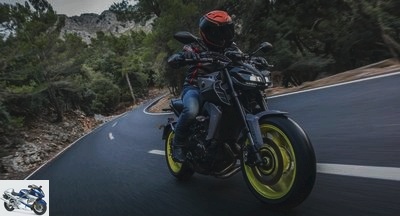
Having become a bestseller in just four years, the Yamaha MT-09 is full of positive developments for 2017: revised design, improved ergonomics, increased equipment … And its 847 cc three-cylinder, in all that ? Rest assured: Euro4 hasn’t made him lose any of his exciting character! Test.
Page 3 – Technical point MT-09 2017
2017 MT-09 engine
Despite its transition to Euro4 standards, the in-line 3-cylinder of the MT-09 has not undergone many changes for 2017: this is the advantage of the modern design of this 847cc block, which engineers revealed to us that it was pre-configured for Euro4 when it was released in 2013. Thus, only the injection and the exhaust have been retouched, with in particular a new internal structure of the gas plenum chamber now in three parts.
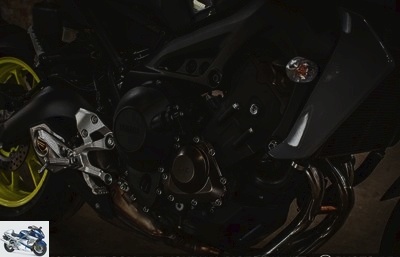
Logically, this “CP3” engine displays the same dimensions (78 mm x 59.1 mm), the same compression ratio (11.5 to 1) and above all identical power and torque values: 115 hp and 87, 5 Nm, obtained at the same speeds (respectively at 10,000 rpm and 8,500 rpm). A very good point at a time when some competing engines sometimes admit a few newton-meters less following their upgrade.
The injection is always controlled by an electronic Rid-by-wire accelerator, subject to three configurable maps while driving. Said injection is carried out through 12-hole injectors mounted directly on the cylinder head, an attractive solution in terms of space saving and spraying efficiency. Despite progress compared to the first model and an update made in 2015, this injection still lacks transparency and progressivity…
Small mechanical peculiarity of the MT-09: it has intake ducts of different lengths (102.88 mm, 82.8 mm and 122.8 mm) in order to improve engine filling at medium and high speeds. This difference in length is also the cause of the sound, "grumpy" at will when the air-gasoline mixture is sucked into each of the 3-cylinders..
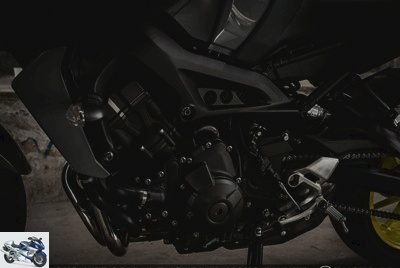
Its cylinders are also offset by 5 mm from the center of the crankshaft so as to be able to better position the connecting rod to reduce the stresses on the piston. In this way, internal friction is reduced to the benefit of efficiency, consumption (“5.5 l / 100 km” according to Yamaha) and mechanical longevity. Engine timing is set at 120 °, i.e. 0 °, 240 ° and 480 ° ignition intervals, so the pistons are never in neutral at the same time.
Identical to that adopted by Triumph on its “3-legs”, this setting combines the advantages: cyclical regularity, good operating range and smoothness. To perfect its qualities, Yamaha has installed a balancing pendulum to filter parasitic vibrations. In use, very slight tremors are felt under the feet when accelerating, especially noticeable because the footrests are not covered with rubber.
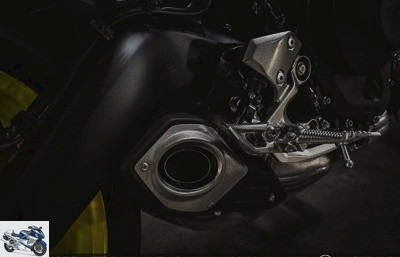
Aesthetically close to the old model, the exhaust system of this lightweight engine (10 kg lighter than the 4-legged of the FZ8!) Is based on a 3-in-1 manifold connected to a short side silencer. The exit is now covered with a metal cover to give the impression of a beveled exit. This low and close arrangement of the engine is excellent for mass centralization.
New in 2017: the clutch adopts an anti-dribble device, which releases the pressure of the discs slightly and briefly to prevent blockages during downshifts. This system also lowers the force to be provided to the left lever, by "20%" according to Yamaha..
Finally, the service interval is set at 1000 km for the traditional "break-in oil change", then "every 10,000 km", reveals Yamaha Motor France about this motorcycle with final transmission by chain.
2017 MT-09 chassis
The die-cast perimeter aluminum frame is identical to the previous generation MT-09. This chassis consists of two parts bolted together at the level of the steering column and the axis of the swinging arm. The whole gives off a pleasant feeling of robustness and is very correctly assembled.
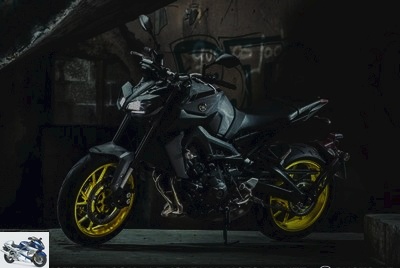
The main change is the 29mm shortening of the rear buckle. Paradoxically, however, the passenger seat extends by 13 mm: the reason is better use of the available space, Yamaha explained to us. Too bad Iwata’s crest didn’t take the opportunity to give it a worthy chest: a yellow vest and a disc lock fit into the space under the saddle, but no more. The rider saddle rises by 5 mm: the position is tilted slightly more to the front.
The frame geometry is identical to 2016, with a short wheelbase of 1440 mm, a caster angle of 25 ° and a caster of 103 mm. These fairly "sporty" values are at the origin of the bike’s agile and playful behavior, but also of its sometimes sharp reactions from the front axle, due to the lack of steering damper. Damping is provided at the rear by a mono-shock absorber adjustable in preload and rebound installed horizontally, an interesting position because the spring and the rods are in this way less exposed to projections.
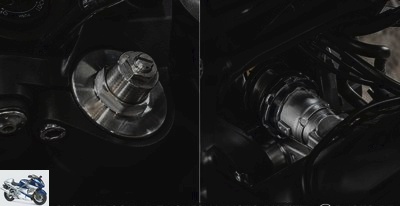
Access to the rebound adjustable screw at the base of the shock is particularly tricky. The spring and hydraulic adjustments of the shock absorber have been revised for 2017 to adapt to the transplant of a more advanced fork, since it is now fully adjustable (preload and rebound in 2016). Adjustments are made on the top of the right tube for rebound and on the left tube for compression.
More efficient, this fork retains its fairly high travel for a roadster: 137 mm (130 mm at the rear). In terms of braking, the MT-09 is adorned at the front with two floating discs of 298 mm bitten by radial calipers with 4 pistons, and at the rear of a 245 mm disc and single piston caliper. This device is not coupled but receives the support of a mandatory ABS in 2017, not adjustable or deactivatable.
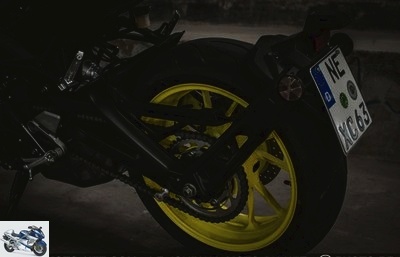
The ten-spoke rims are made of aluminum and fitted with Bridgestone S20s as standard equipment. Finally, note the grafting of a deported plate support, in the form of an aluminum arm fixed to the asymmetric swingarm, also in aluminum. Finally, the full weight is 193 kg, up 2 kg compared to 2016. The explanation for this increase is due to the aesthetic changes (transplant of radiator scoops, the offset plate support and the double headlight, in particular) as well as the addition of equipment such as the shifter.
Electronics, piloting aids
As mentioned above, the MT-09 receives three different injection maps, selectable from the right stalk. These three modes offer a more or lively response to acceleration depending on whether the map "A" (the most sporty), "standard" and "B" (useful in the wet) is selected. The passage from one to the other can be done while driving, gas cut.
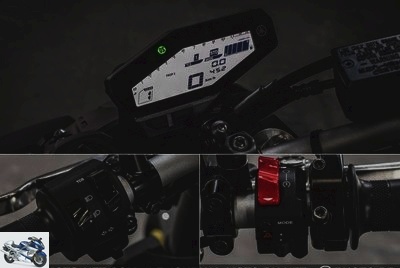
As in 2016, this device intervenes only on the way in which the power is delivered, and not on its value: the 115 hp are present regardless of the mode engaged. Heavily criticized for the lack of progressiveness and the jerks generated by the injection in the past (especially in mode A), Yamaha has fine-tuned its operation … but it is not yet completely satisfactory. On a daily basis, the "B" mode is the most pleasant because the softest.
Since 2016, the MT-09 has been fitted as standard with the "TCS" (Traction Control System) traction control, a device introduced by Yamaha on the Super Tenere in 2010, then on the 2012 R1 and on the FJR1300 the following year. Disconnectable when stationary from the dashboard, this traction control is continuously informed about the speed of rotation of the wheels by the toothed crowns of the ABS.
As soon as it detects a difference between the front and the rear, the ECU (the electronic brain of the system) crosses this information with that collected by the electronic accelerator (gear engaged, engine speed, degree of throttle opening , in particular) and adapts its action accordingly. In the event of a brief loss of traction, it will order, for example, a slight closing of the throttle flaps via the ride-by-wire in order to regulate the power and restore grip to the rear wheel. If the slip is more marked, the TCS will then intervene on the ignition advance, intervention more sensitive to the handlebars.
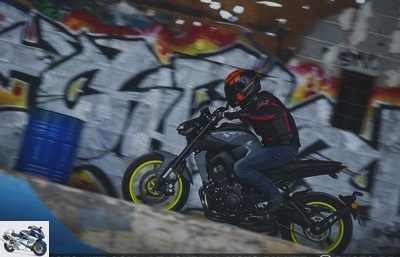
Finally, if this is not enough or the situation turns to the extreme, the device will opt for an ignition cut-off, in this case causing sudden activation and jerky operation. In all cases, its entry into service is signaled by the flashing of an orange "TCS" light on the bottom of the fully digital dashboard, repositioned on the headlight for better readability..
Fairly simple in its operation, the Yamaha TCS is not informed by gyroscopes capable of indicating the inclination of the motorcycle. However, its well-calibrated intervention threshold and its good reactivity make it sufficiently efficient and pleasant in the vast majority of cases. The only complaints: adjusting its sensitivity (on two levels) or deactivating it is impossible while driving … And it does not tolerate wheeling triggered at the clutch, even on its least interventionist threshold (1), unlike that of the MT-10 !
Finally, the last welcome addition to the 2017 MT-09: a stock shifter that only works when upshifting. This device hitherto reserved for sports motorcycles causes an ignition micro-cut when the selector is used, which allows upshifting without disengaging or cutting the throttle. In use, this shifter is really practical and its correct functioning, without however achieving the responsiveness and flexibility of that of the R1 from which it derives.
Related articles
-
Roadster – Yamaha MT-09 SP test: the one we SPEED! – MT-09 SP test page 3: Technical point
Yamaha MT-09 SP test: the one we Sought ! The Yamaha MT-09, one of the stars of the French motorcycle market, never ceases to enchant bikers eager for…
-
Yamaha Niken test: trying the three-wheeled motorcycle is taming it ! For more than ten years, Yamaha engineers have been racking their brains to offer a…
-
2017 Yamaha YZF-R6 test: no, the Supersport is not dead Yamaha is the only major motorcycle manufacturer to keep its 600 cc sports car in its catalog in…
-
2017 Yamaha MT-09 review: mult (r) iples pleasures ! Having become a bestseller in just four years, the Yamaha MT-09 is full of positive developments for…
-
All Tests – MT-09 Tracer Test: Yamaha traces to success! – Technical update MT-09 Tracer 2015
Test MT-09 Tracer: Yamaha traces to success ! In 1991, Yamaha set foot in the dish with TDM, a multi-genre and multitasking motorcycle. 23 years later,…
-
All Tests – MT-09 Test: Yamaha’s future road’star ‘! – Technical point Yamaha MT-09
MT-09 test: Yamaha’s future road star ! Symbol of a new era to come, Yamaha unveiled a new three-cylinder almost a year ago. The first motorcycle to be…
-
Comparison test Kawasaki Z900, Suzuki GSX-S750 and Yamaha MT-09: Election of the best Japanese maxi-mid-size roadster In 2017, Kawasaki further…
-
Comparison test Kawasaki Z900, Suzuki GSX-S750 and Yamaha MT-09: Election of the best Japanese maxi-mid-size roadster In 2017, Kawasaki further…
-
2018 BMW F 750 GS and F 850 GS test: which one to choose ? In 2018, the BMW F750GS and F850GS gain in displacement and technology to succeed the F700GS…
-
2017 Suzuki V-Strom 1000 XT test: a super cost ! The Suzuki V-Strom 1000 , relaunched in 2013 after a career suspension in 2008 due to Euro 3 standards,…